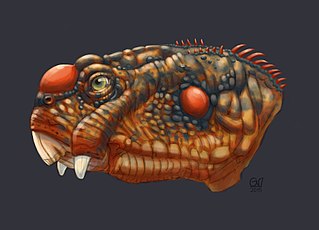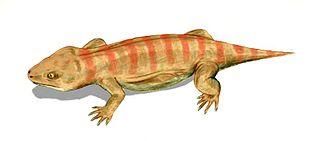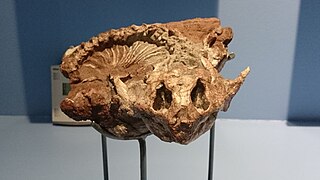
Lystrosaurus is an extinct genus of herbivorous dicynodont therapsids from the late Permian and Early Triassic epochs. It lived in what is now Antarctica, India, China, Mongolia, European Russia and South Africa. Four to six species are currently recognized, although from the 1930s to 1970s the number of species was thought to be much higher. They ranged in size from that of a small dog to 8 feet long.

Ericiolacerta is an extinct genus of small therocephalian therapsids from the early Triassic of South Africa and Antarctica. Ericiolacerta, meaning "hedgehog lizard", was named by D.M.S. Watson in 1931. The species E. parva is known from the holotype specimen which consists of a nearly complete skeleton found in the Lystrosaurus Assemblage Zone within the Katberg Formation of the Beaufort Group in South Africa, and from a partial jaw found in the Lower Triassic Fremouw Formation in Antarctica. Ericiolacerta was around 20 centimetres (7.9 in) in length, with long limbs and relatively small teeth. It probably ate insects and other small invertebrates. The therocephalians – therapsids with mammal-like heads – were abundant in Permian times, but only a few made it into the Triassic. Ericiolacerta was one of those. It is possible that they gave rise to the cynodonts, the only therapsid group to survive into post-Triassic times. Cynodonts gave rise to mammals.

The Daptocephalus Assemblage Zone is a tetrapod assemblage zone or biozone found in the Adelaide Subgroup of the Beaufort Group, a majorly fossiliferous and geologically important geological Group of the Karoo Supergroup in South Africa. This biozone has outcrops located in the upper Teekloof Formation west of 24°E, the majority of the Balfour Formation east of 24°E, and the Normandien Formation in the north. It has numerous localities which are spread out from Colesberg in the Northern Cape, Graaff-Reniet to Mthatha in the Eastern Cape, and from Bloemfontein to Harrismith in the Free State. The Daptocephalus Assemblage Zone is one of eight biozones found in the Beaufort Group and is considered Late Permian (Lopingian) in age. Its contact with the overlying Lystrosaurus Assemblage Zone marks the Permian-Triassic boundary.

The Lystrosaurus Assemblage Zone is a tetrapod assemblage zone or biozone which correlates to the upper Adelaide and lower Tarkastad Subgroups of the Beaufort Group, a fossiliferous and geologically important geological Group of the Karoo Supergroup in South Africa. This biozone has outcrops in the south central Eastern Cape and in the southern and northeastern Free State. The Lystrosaurus Assemblage Zone is one of eight biozones found in the Beaufort Group, and is considered to be Early Triassic in age.

Procolophon is a genus of lizard-like procolophonid parareptiles that first appeared in the Early Triassic (Induan) of South Africa, Brazil, and Antarctica. It persisted through the Permian–Triassic extinction event, but went extinct in the beginning of the Early Middle Triassic. The type species is P. trigoniceps.

Lydekkerina is an extinct genus of stereospondyl temnospondyl. It is the type genus of the family Lydekkerinidae. Fossils have been collected from Early Triassic deposits in South Africa and Australia. The type species is L. huxleyi, first described in 1889. While most other stereospondyls were semiaquatic, Lydekkerina was exclusively terrestrial.
Platycraniellus is an extinct genus of carnivorous cynodonts from the Early Triassic. It is known from the Lystrosaurus Assemblage Zone of the Normandien Formation in South Africa. P. elegans is the only species in this genus based on the holotype specimen from the Ditsong National Museum of Natural History in Pretoria, South Africa. Due to limited fossil records for study, Platycraniellus has only been briefly described a handful of times.

Owenetta is an extinct genus of owenettid procolophonian parareptile. Fossils have been found from the Beaufort Group in the Karoo Basin of South Africa. Although most procolophonians lived during the Triassic, Owenetta existed during the Wuchiapingian and Changhsingian stages of the Late Permian as well as the early Induan stage of the Early Triassic. It is the type genus of the family Owenettidae, and can be distinguished from other related taxa in that the posterior portion of the supratemporal bears a lateral notch and that the pineal foramen is surrounded by a depressed parietal surface on the skull table.

Owenettidae is an extinct family of procolophonian parareptiles. Fossils have been found primarily from Africa and Madagascar, with one genus present from South America. It is the sister taxon to the family Procolophonidae. Modesto and Damiani (2007) defined Owenettidae as a stem-based group including Owenetta rubidgei and all species closely related to it than to Procolophon trigoniceps.

Procolophonoidea is an extinct superfamily of procolophonian parareptiles. Members were characteristically small, stocky, and lizard-like in appearance. Fossils have been found worldwide from many continents including Antarctica. The first members appeared during the Late Permian in the Karoo Basin of South Africa.

Langbergia is an extinct genus of trirachodontid cynodont from the Early Triassic of South Africa. The type and only species L. modisei was named in 2006 after the farm where the holotype was found, Langberg 566. Langbergia was found in the Burgersdorp Formation in the Beaufort Group, a part of the Cynognathus Assemblage Zone. The closely related trirachodontids Trirachodon and Cricodon were found in the same area.
Kitchingnathus is an extinct genus of basal procolophonid parareptile from Early Triassic deposits of Eastern Cape Province, South Africa. It is known from the holotype BP/1/1187, skull and partial postcranium, which was first assigned to the more derived Procolophon trigoniceps. It was collected by the South African palaeontologist, James W. Kitching in October 1952 from Hobbs Hill, west of Cathcart. It was found in the middle or upper part of the Katberg Formation of the Beaufort Group and referred to the uppermost Lystrosaurus Assemblage Zone. It was first named by Juan Carlos Cisneros in 2008 and the type species is Kitchingnathus untabeni. The generic name honours James W. Kitching, and "gnathus", from Greek gnathos meaning mandible. The specific name meaning "from the hill", in isiZulu, is in reference to the locality where the fossil was found.

Sauropareion is an extinct genus of basal procolophonid parareptile from earliest Triassic deposits of Eastern Cape Province, South Africa. It is known from the holotype SAM PK-11192, skull and partial postcranium. It was collected by the late L. D. Boonstra in 1935 from Barendskraal in the Middelburg District and referred to the Lystrosaurus Assemblage Zone of the Beaufort Group. It was first named by Sean P. Modesto, Hans-Dieter Sues and Ross J. Damiani in 2001 and the type species is Sauropareion anoplus. The generic name means "lizard", sauros, and "cheek", pareion from Greek in reference to the lizard-like appearance of the temporal region. The specific name comes from the Greek word anoplos, meaning "without arms or armour".
Coletta is an extinct genus of basal procolophonid parareptile from Early Triassic deposits of Eastern Cape Province, South Africa. It is known from the holotype GHG 228, a skull with fragmentary lower jaws. It was collected on the farm Brakfontein 333 in the Cradock District. It was found in the Katberg Formation of the Beaufort Group and referred to the Lystrosaurus Assemblage Zone. It was first named by Christopher E. Gow in 2000 and the type species is Coletta seca.
Pintosaurus is an extinct genus of basal procolophonid parareptile from Late Triassic deposits of northeastern Uruguay. It is known from the holotype FC-DPV 1181, a partial skull. It was collected from the Buena Vista Formation of the Paraná Basin, in Colonia Orozco, Cerro Largo Department. It was first named by Graciela Piñeiro, Alejandra Rojas and Martín Ubilla in 2004 and the type species is Pintosaurus magnidentis. The generic name honours Dr. Iraja Damiani Pinto. The specific name means "with a large tooth" in Latin, a reference to the large palatal tooth pair.
Theledectes is an extinct genus of theledectine procolophonid parareptile from middle Triassic deposits of Free State Province, South Africa.The type species, Theledectes perforatus, is based on the holotype BP/1/4585, a flattened skull. This skull was collected by the South African palaeontologist, James W. Kitching from Hugoskop in the Rouxville District and referred to subzone B of the Cynognathus Assemblage Zone of the Burgersdorp Formation, Beaufort Group. The genus was first named by Sean P. Modesto and Ross J. Damiani in 2003. However, the species was initially assigned to the genus Thelegnathus by C.E. Gow in 1977, as the species Thelegnathus perforatus.

Teratophon is an extinct genus of procolophonine procolophonid parareptile from middle Triassic deposits of Free State Province, South Africa. It is known from the holotype BP/1/4299, a nearly complete skull. It was collected by the South African palaeontologist, James W. Kitching from Hugoskop in the Rouxville District and referred to subzone B of the Cynognathus Assemblage Zone of the Burgersdorp Formation, Beaufort Group. It was first named by Sean P. Modesto and Ross J. Damiani in 2003 and the type species is Teratophon spinigenis. It was first assigned to a species of Thelegnathus, Thelegnathus spinigenis. The distinguishing feature of this genus is a noticeable posterolateral spine-like process of the quadratojugal.
Thelephon is an extinct genus of procolophonine procolophonid parareptile from middle Triassic deposits of Free State Province, South Africa. It is known from the holotype BP/1/3512, a partial skull lacking the snout and anterior third of the mandible. It was collected by the South African palaeontologist, James W. Kitching from Hugoskop in the Winnaarsbaken and referred to subzone B of the Cynognathus Assemblage Zone of the Burgersdorp Formation, Beaufort Group. It was first named by Sean P. Modesto and Ross J. Damiani in 2003 and the type species is Thelephon contritus. It was first assigned to a species of Thelegnathus, Thelegnathus contritus.
Thelerpeton is an extinct genus of procolophonine procolophonid parareptile from middle Triassic deposits of Free State Province, South Africa. It is known from the holotype BP/1/4538, a nearly complete skull. It was collected by the South African palaeontologist, James W. Kitching from Hugoskop in the Rouxville District and referred to subzone B of the Cynognathus Assemblage Zone of the Burgersdorp Formation, Beaufort Group. It was first named by Sean P. Modesto and Ross J. Damiani in 2003 and the type species is Thelerpeton oppressus. It was first assigned to a species of Thelegnathus, Thelegnathus oppressus.
Barasaurus is an extinct genus of owenettid procolophonoid parareptile known from the Late Permian and Early Triassic of Madagascar. It contains a single species, Barasaurus besairiei.















